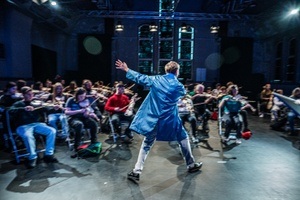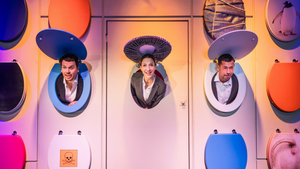PHOTO:
© Foto © 2012, Leo Seidel
Hänsel und Gretel
In the organizer's words:
The Grimm fairy tale is well known, Humperdinck's score oscillates between nursery rhyme and late romantic, opulent Wagnerian sound. Andreas Homoki's lovingly child-friendly production of the Christmas opera classic has been in the repertoire of the house for almost 25 years and continues to inspire children, parents and grandparents for the world of musical theater ... Conductor: Dominic Limburg; Director: Andreas Homoki; With Samuel Dale Johnson / Joel Allison, Maria Motolygina / Ulrike Helzel, Irene Roberts / Karis Tucker, Meechot Marrero / Alexandra Hutton, Burkhard Ulrich / Patrick Cook, Sua Jo and others.Hansel and Gretel are the children of a poor broom maker and his wife. When one day they play boisterously instead of doing their work, their mother sends them into the forest to gather berries as punishment. Shortly thereafter, after a successful day, the father comes home jolly and with a basket full of delicious things. He reproaches his wife for the children, because a dangerous witch is wreaking havoc in the forest. The parents set off in search of their children. In the meantime, Hansel and Gretel have filled their baskets, but have eaten all the berries themselves out of sheer hunger. When they want to look for new ones, they realize that it has already become dark. They have lost their way in the forest. They decide to go to sleep and say their evening prayer. In their dreams they experience wonderful things. The next morning they find themselves in front of a strange house made of gingerbread and sugar stuff. When they want to nibble on it, the witch suddenly appears and takes them prisoner. Hansel is to be roasted in the oven, but by a trick the children manage to push the witch into the oven instead. At the same moment, the spell wears off and all the many children, who had already been turned into gingerbread by the witch, regain their shape and are freed. When the parents also appear, the family is finally reunited. Happily they go home.
For over 100 years, Engelbert Humperdinck's HÄNSEL UND GRETEL has been one of the most popular operas for the whole family. Traditionally performed around Christmas, the work was initially considered "family evil" in the Humperdinck family circle. Adelheid Wette, the composer's sister, had written a fairy tale play for her children based on the Brothers Grimm fairy tale of the same name and had asked her brother to set some songs from it to music. The piece, called a "Kinderstuben-Weihfestspiel" in the family jargon of the Wagner enthusiast Humperdinck, was to be performed on the occasion of the father's birthday. What saw the light of day in 1890 as a piano version was completed by the composer three years later as a grand opera. Humperdinck had not been able to resist the temptation to turn the work, with its catchy melodies and dramatic story not only for children, into a two-hour symphonic masterpiece. It has been translated into more than twenty languages and still today represents for many children their first encounter with the world of opera.
Musically, the demanding work does not hide its closeness to Wagner, but is also able to captivate less experienced ears. Cleverly placed "evergreens" such as Ein Männlein steht im Walde, Abends wenn ich schlafen geh', vierzehn Englein um mich stehn or Der kleine Sandmann bin ich help with orientation and remain in the memory long after the stage lights have gone out.
Andreas Homoki and his stage designer Wolfgang Gussmann tell the story in a child-friendly and straightforward manner. They counter the opulence of the music with lightness and poetic imagery, which reaches its magical climax especially in the night scenes in the forest. Of course, drama and theatrically effective scary effects are not missing, and the appearance of the witch, eagerly awaited by all children, is staged in an exciting way, but not without comedy. Children as young as about eight will enjoy Humperdinck's fairy tale play, in which the battle against evil is won in the end and Hansel and Gretel, through their courage and ingenuity, show the way to freedom not only for themselves but also for all the other children turned into gingerbread by the witch.
"Director Andreas Homoki does not want to abuse the play for psychological quibbles or ideological announcements. He wants to show a play for children. With intelligence and with playfulness he goes to work ... " [DeutschlandRadio Cologne] This content has been machine translated.





